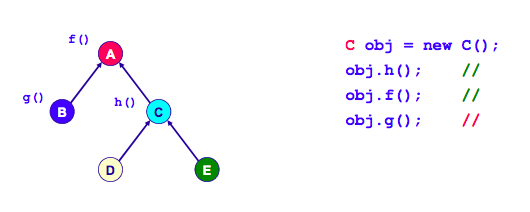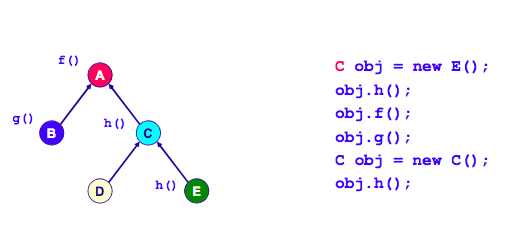A reference ( or pointer ) variable has two types associated with it
- static type
- the type declared at program
- fixed and never changed
- dynamic type
- the type of object it actually refers to
- can be changed during lifetime
Example)
Movie m = new Movie();
m = new JamesBondMovie();<br>
JamesBondMovie jm;
jm = new JamesBondMovie();
m = jm; ---> NO ERROR!!
jm = m; ---> ERROR!!
( static type 을 가지고서 판단한다.<br> jm 의 static type 은 jm 이기 떄문에 자식은 부모의 특성 + @ 를 가지고 있기 때문에 부모는 자식을 포한하는 관계는 아니다.<br> 따라서 jm != m 이다 )
A subclasses can be assigned to its superclass, but not vice versa
—————–
- assign direction
- super class <—- sub class O
- sub class <—- super class X
- super class <—- sub class O
- CHECK STATIC TYPE

obj.h(), obj.f() –> O
obj.g() –> X
When message is sent to a receiver object, the complier checks its legality by performing an operation lookup using static type
- static type 의 root 로 올라가 check
- static type direction 으로 내려오면서 check
The compiler searches up starting from the STATIC type util it finds the invoked operation
- CHECK DYNAMIC TYPE

obj.h() —> O ( E’s h() )
obj.f() —> O ( A’s f() )
obj.g() —> X
obj.h() —> C’s h()
When message is sent to a receiver, the runtime selects an operation using dynamic type
The runtime searches up starting from the DYNAMIC type until it finds the first invoked operation
Actually, the determination of what behavior to perform may be made at compile-time or at run-time
- At compile-time
- Static binding or Early binding
- Static functions in JAVA / C++
- Nonvirtual functions in C++
- At run time
- Dynamic binding or Late binding
- Virtual function in JAVA / C++